
table of contents
- Climbing plants
- Annual climbing plants
- Plants from D to F
- Plants from G to K
- Plants from M to T
- Perennial climbing plants
- Plants from A to E
- Plants from G to K
- Plants from P to W
Climbing plants not only green walls, fences or building facades, but are also a natural privacy screen. So that bald spots disappear quickly, the hobby gardener should plant a fast-growing climbing plant and be spoiled for choice. Fast-growing climbers can be annual or perennial. To make your selection easier, we have put together some fast-growing climbing plants for you.
Climbing plants
Annual climbing plants
Climbing plants that are labeled annual cannot be overwintered because their lifespan ends in autumn. Nevertheless, many of these climbing plants develop wonderful flowers and dense foliage during their short life. Since they do not need winter quarters, they are particularly suitable for balconies or patios.
Plants from D to F
Sweet peas (Lathyrus)
Fast-growing sweet peas, also called sweet peas or garden peas, do not bear their name for nothing, because they give off an intense scent. The climbing plants can be cultivated outdoors or in pots. The climbing plants look particularly pretty when different shades of color, ranging from white to purple, are combined with one another.
- Height: up to 2 meters
- Planting time: from April
- Location: sunny and sheltered from the wind (avoid blazing midday sun)
- Flowering period: June to August
Tip: The flowers of the climbing plants are also a real eye-catcher in the vase.

Exploding cucumber (Cyclanthera brachystachya)
Exploding cucumbers do not bear their name for nothing, as their small cucumbers explode to multiply and thus spread the seeds meters wide. The fast-growing climber has inconspicuous flowers and yellow-green, medium-sized leaves. It can be cultivated outdoors or in a bucket.
- Height: up to 5 meters
- Planting time: from May
- Location: sunny
- Flowering time: summer
Tip: The small cucumbers from Cyclanthera brachystachya are edible.

Fire bean (Phaeolus coccineus)
Fire beans, also called beetle beans, have red flowers, from which the bean pods gradually form. The climbing plants are suitable for free-range and bucket-keeping.
- Height: up to 3.5 meters
- Planting time: from mid-May after the ice saints
- Location: sun to partial shade
- Flowering period: June to September
Tip: The raw beans are poisonous and must therefore be cooked before consumption.
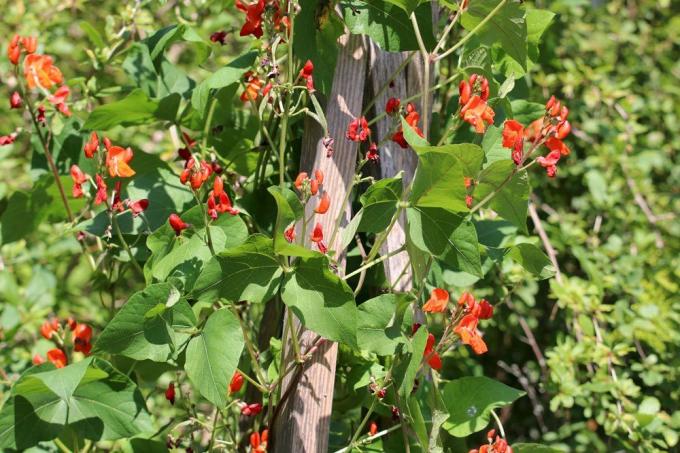
Flamingo flower (Dalechampia mathea)
These exotic climbing plants impress with their two pink leaves that surround the inconspicuous flowers. Their medium-sized leaves offer good privacy protection.
- Height: up to 5 meters
- Planting time: from mid-May after the ice saints
- Location: sunny
- Flowering time: summer
Tip: The leaves of the flamingo flower have nettle hairs that can cause skin irritation.
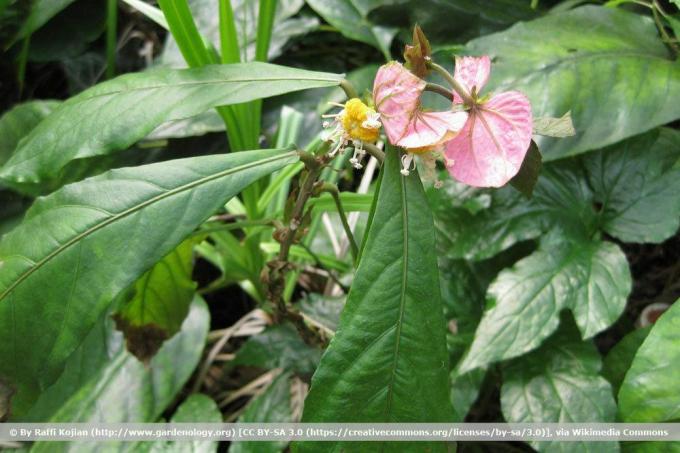
Plants from G to K
Bell vine (Cobaea scandens)
The bell vine, also called clawed or bell winds, impresses with its many bell-shaped flowers that exude a honey-sweet scent. Cobaea scandens is available in white, yellow, pink, lavender or violet. The fast-growing climber can be grown in pots on the balcony or outdoors.
- Height: up to 8 meters
- Planting time: from mid-May after the ice saints
- Location: full sun
- Flowering period: July to October
Tip: The bell vine is an excellent source of food for bees and butterflies.

Great nasturtium (Tropaeolum majus)
The nasturtium blooms in bright yellow, orange or red. When flowers or leaves are harvested, Tropaeolum majus gives off a spicy scent. It can be grown outdoors or in a tub.
- Height: up to 3 meters
- Planting time: from the end of May
- Location: sun to partial shade
- Flowering period: May to October
Tip: Flowers and leaves are ideal as an addition to salads.

Japanese hops (Humulus japonicus)
With its 10 to 15 ten meter large leaves, the fast-growing Japanese hops are an optimal privacy screen, as their leaves are one of the densest among the climbing plants. Instead, its flowers are rather small and simple. Humulus japonicus likes dry soil outdoors, but the fast-growing climber should always be kept moist in the container culture.
- Height: up to 4 meters
- Planting time: from April
- Location: shade
- Flowering time: summer
Tip: In the open field, you should plan a distance of 60 centimeters between the climbing plants.

Climbing snapdragons (Asarina scandens)
Da climbing snapdragons belongs to the gloxinia winds (Asarina). The lifespan of the climbing plants is often given as one year, but it can be overwintered indoors. The climbing plants come in many colors, which is why there are often colorful mixtures in specialist shops.
- Height: up to almost 2 meters
- Planting time: mid-May to June
- Location: sunny
- Flowering period: May to October
Tip: Bring the climbing snapdragon inside before the first frost, then it will often bloom until Christmas.
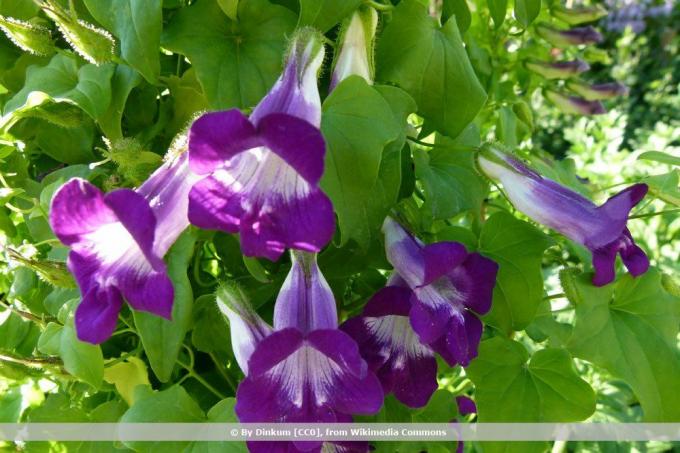
Pumpkins (Cucurbita)
Pumpkins, including the popular Hokkaido pumpkin, can also be grown as climbing plants. If they are offered a climbing aid, they quickly form a wall of leaves. And, depending on the variety, the fruits can be harvested in autumn.
- Height: 3 - 10 meters, depending on the variety
- Planting time: from mid-May after the ice saints
- Location: sun or partial shade
- Flowering time: June to November, depending on the variety
Tip: You don't need a garden to plant pumpkins. They also thrive in pots on the balcony.

Plants from M to T
Mandevilla (Dipladenia)
The blossoms of the climbing varieties of the Mandevilla, also called Chilean jasmine, diamanta, sundaville or tropidenia, are somewhat reminiscent of oleander blossoms. The funnel-shaped flowers are white, pink or red in color.
- Height: up to 5 meters
- Planting time: from mid-May after the ice saints to June
- Location: sunny and protected from rain
- Flowering period: May to October
Tip: Some climbing varieties can also be overwintered indoors.

Pipe flower (aristolochia)
Pipe flowers have very large, red-brown flowers in a bizarre funnel shape. The climbing plants can smell unpleasant or good, depending on the variety. Their overlapping, heart-shaped leaves form an extremely dense canopy.
- Height: up to 6 meters
- Planting time: from mid-May after the ice saints
- Location: partial shade to shade
- Flowering period: June to autumn
Tip: Since Aristolochia is poisonous, it is better to avoid climbing plants in households with children.

Morning glory (ipomomea)
There are over 650 species of the morning glory genus. The purple morning glory (Ipomoea purpurea) and the sky-blue morning glory (Ipomoea tricolor) are cultivated as ornamental plants. The funnel-shaped flowers of the climbing plants are pink to purple. The fast-growing climbing plants can be grown in pots or outdoors.
- Height: at least 2.5 meters
- Planting time: from mid-May after the ice saints (hardening recommended)
- Location: sunny
- Flowering period: July to October
Tip: Since many species of morning glory are poisonous, you should not do without gloves when working with the climbing plant.

Black-eyed Susan (Thunbergia alata)
The flowers of the black-eyed Susanne have a large black eye in the middle, which sets the mostly orange-yellow flowers in the limelight. Since it develops very strong roots, it needs a lot of space outdoors and a large pot in the container culture.
- Height: up to 2 meters
- Planting time: mid-May after the ice saints
- Location: sunny and sheltered from the wind
- Flowering period: May to October
Tip: With a growth of up to 20 centimeters per week, the black-eyed Susanne is truly a fast climber.
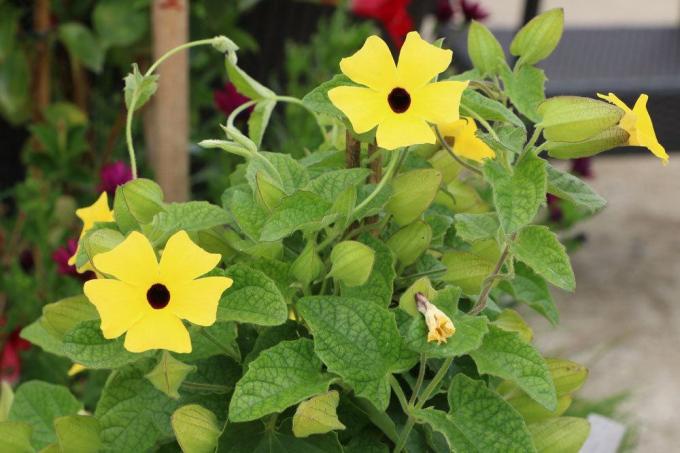
Morning Glory (Ipomoea indica)
The mostly blue flowers of the funnel wind only last one day at a time. However, flowers keep coming, so that the sea of flowers never ends. Ipomoea indica tolerates calcareous soil, but can also be cultivated in a tub on the balcony or terrace.
- Height: at least 3 meters
- Planting time: spring (depending on the weather, protection from the cold is necessary)
- Location: sun to shade
- Flowering period: July to October (depending on the weather even before that)
Tip: The fast-growing bindweed leads to poisoning if consumed. Therefore, caution should be exercised in households with small children or pets.
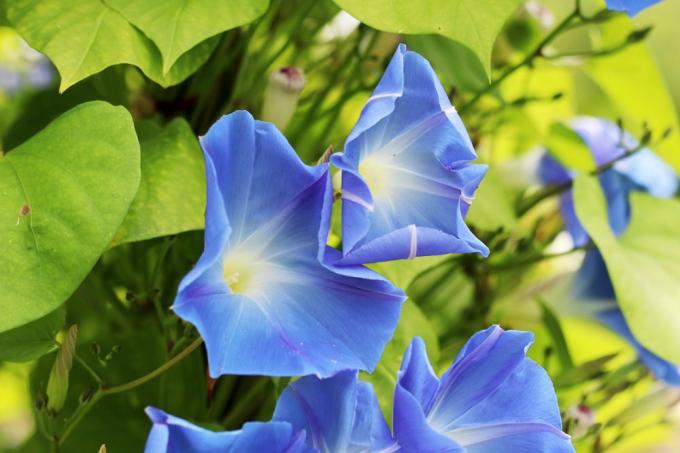
Perennial climbing plants
If climbing plants are perennial, this does not necessarily mean that they are hardy, because this information only relates to the possible lifespan of the plants. Therefore, you should not cultivate hardy climbing plants in the tub so that they can move to winter quarters for the cold season.
Plants from A to E
American climbing trumpet (Campsis radicans)
The deciduous American climbing trumpet has yellow to brick-red funnel-shaped flowers. The fast-growing self-climber can withstand temperatures down to minus 20 degrees Celsius.
- Height: 5 to 10 meters, some varieties even more
- Planting time: late spring
- Location: sunny to partially shaded
- Flowering period: July to September
Tip: The American climbing trumpet is poisonous in all parts of the plant. As it can cause irritation and reddening of the skin, you should always wear gloves when working with the plant.
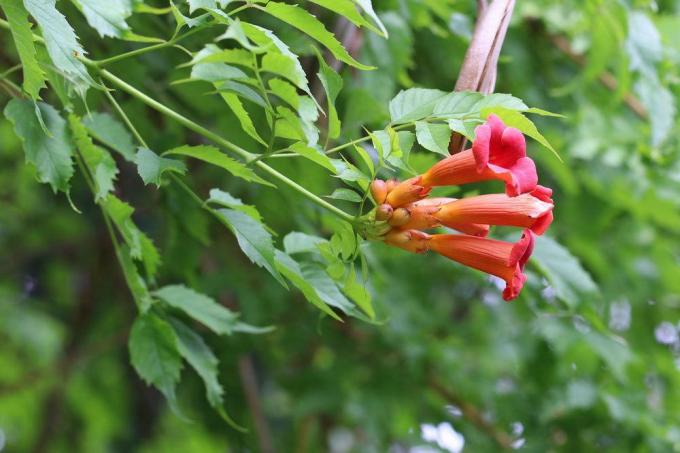
Wisteria
The wisteria, also called wisteria or wisteria, forms flower clusters up to 50 centimeters long, depending on the variety. The colors of the flowers are white, blue or purple. With an annual growth of up to 150 centimeters, the wisteria is a truly fast-growing climber.
- Growth height: 4 to 8 meters and more, depending on the variety
- Planting time: late spring
- Location: sun to partial shade
- Flowering period: May to July
Tip: The wisteria must be cut regularly, otherwise building facades can be damaged.
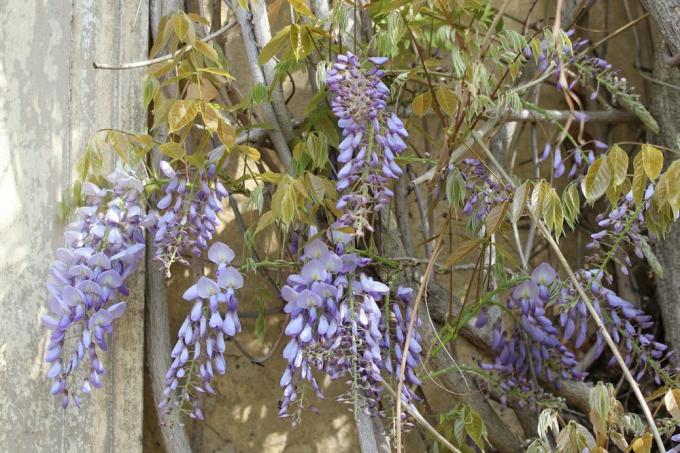
Ivy (Hedera helix)
The evergreen ivy tirelessly grows up on house walls. In adulthood it even develops small, yellowish-green flowers. The fruits of ivy are inedible for humans, but are on the menu of many birds.
- Height: 20 meters and more
- Planting time: spring
- Location: shady to shady
- Flowering time: autumn
Tip: So that the ivy does not overgrow everything, you should cut it regularly.

Plants from G to K
Honeysuckle (Lonicera)
The fast-growing honeysuckle, also known as the honeysuckle, gives off a seductive scent that attracts bees, bumblebees and butterflies. The lush flowers shine in yellow or red. Depending on the variety, the climbing plants are evergreen or deciduous.
- Height: from 3 meters
- Planting time: early spring (frost-free soil)
- Location: Sun to partial shade, depending on the variety
- Flowering period: May to September, depending on the variety
Tip: With a trellis, the honeysuckle also thrives splendidly in the bucket.

Virgin vine (Parthenocissus)
Virgin vines, also known as fence vines or wild vines, have inconspicuous creamy white to slightly yellow flowers. After flowering, small, blue-black berries that are reminiscent of grapes develop. Most varieties of the maiden vines shed their leaves after an impressive autumn color.
- Growth height: up to 20 meters, depending on the variety
- Planting time: mid-May after the ice saints
- Location: sun to shade
- Flowering period: early or late summer
Tip: Virgin vines are an important source of food for bees.

Climbing hydrangea (Hydrangea petiolaris)
Climbing hydrangeas have large, white, panicle-shaped flowers. The hardy and urban climatic climbers are good nutrients for insects. After the autumn color, the climbing plants shed their leaves.
- Height: 3 to 6 meters
- Planting time: early spring (frost-free soil)
- Location: sun to shade
- Flowering period: June to July
Tip: The climbing hydrangea should be supported for the first two years, after which it climbs on without help.

Climbing rose
Climbing roses are suitable for arches, fences or trellises. Depending on the genus, climbing roses bloom once or several times a year. In winter, the plants need good winter protection on the foot, for example from brushwood or spruce branches.
- Growth height: 1.5 to 5 meters, depending on the variety
- Planting time: autumn
- Location: sunny to partially shaded (no extremely hot locations)
- Flowering time: late May to October, depending on the variety
Tip: In order for the climbing roses to climb, they have to be tied up.
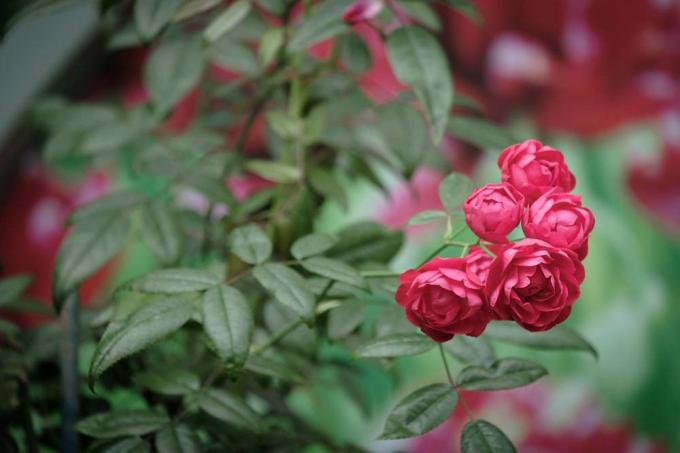
Plants from P to W
Passion flowers (Passiflora)
There are over 530 types of passion flower in a wide variety of colors. Since the climbing plants are only hardy in very mild regions, they should be kept in pots. The fast-growing plant is evergreen and can be overwintered in a bright spot inside.
- Height: 10 to 12 meters
- Planting time: mid-May after the ice saints
- Location: sun
- Flowering period: April to September
Tip: If the climbing aid is connected to the planter, you do not need to unwind the climbing plants for wintering.

Rose goblet (Rhodochiton atrosaguineus)
The rose goblet, also called rose mantle, rose dress, purple bell wine or purple bells, impresses with its long-lasting, scarlet flowers. In order to survive the German winter, the fast-growing climber has to move to winter quarters during the cold season.
- Height: up to 2 meters
- Planting time: mid-May after the ice saints
- Location: full sun
- Flowering period: July to August
Tip: Cut the rose goblet back before moving to winter quarters.

Clematis
There are around 300 species of the hardy clematis, also known as clematis. Depending on the variety, they are evergreen or deciduous. Clematis come in a wide variety of flower colors, and the flower size also varies from variety to variety.
- Height: 2 to 8 meters, depending on the variety
- Planting time: from mid-May after the ice saints
- Location: sunny to partially shaded
- Flowering time: May to October, depending on the variety
Tip: To extend the flowering period, combine spring and summer-flowering clematis varieties.
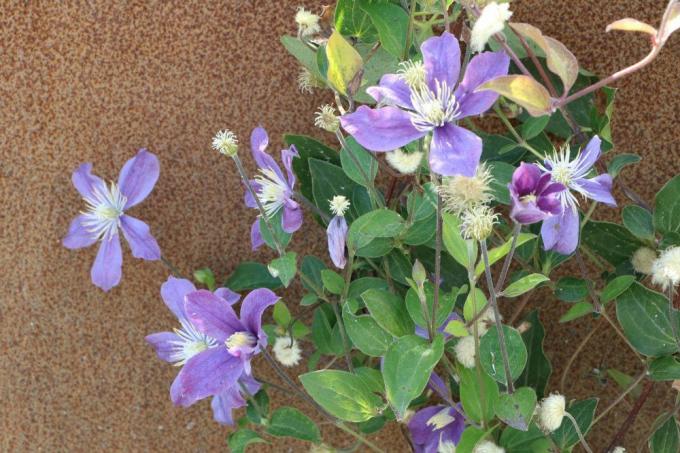
Grapevines (Vitis)
Grapevines quickly climb up facades or climbing aids. Depending on the variety, vines grow up to three meters a year. There are different varieties of Vitis, so that green or blue grapes can be harvested in autumn.
- Height: 2 to 8 meters, depending on the variety
- Planting time: from April
- Location: sunny and sheltered
- Flowering period: April to early summer
Tip: Grapevines need to be pruned regularly.

